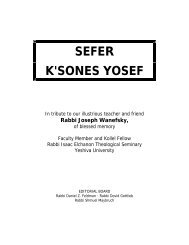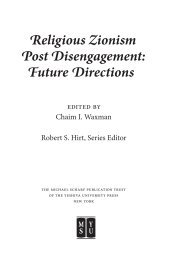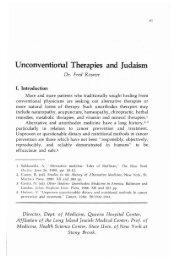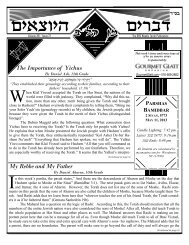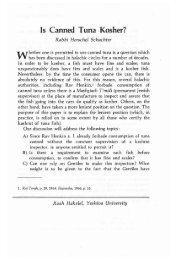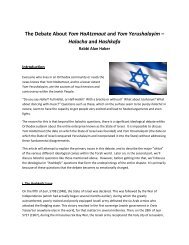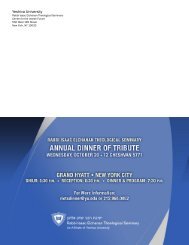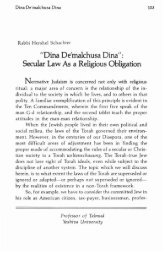yeshiva university • purim to-go • adar 5771 - YU Torah Online
yeshiva university • purim to-go • adar 5771 - YU Torah Online
yeshiva university • purim to-go • adar 5771 - YU Torah Online
- No tags were found...
Create successful ePaper yourself
Turn your PDF publications into a flip-book with our unique Google optimized e-Paper software.
A Life of GivingRabbi Reuven BrandRosh Kollel, Yeshiva University <strong>Torah</strong> Mitzion Kollel of Chica<strong>go</strong>A Season of Giving“If it should please the king, write <strong>to</strong> destroy [the Jews]and [I will pay] 20,000 kikar of silver” Reish Lakish says,it was clear <strong>to</strong> the Crea<strong>to</strong>r of the World that in the futureHaman would take out shekalim for the Jewish people,and therefore He committed [the Jewish people’s]shekalim before his.Megilla 13bאם על המלך טוב יכתב לאבדם ועשרתאלפים ככר כסף וגו' אמר ריש לקיש: גלויוידוע לפני מי שאמר והיה העולם שעתידהמן לשקול שקלים על ישראל, לפיכךהקדים שקליהן לשקליו. והיינו דתנן: באחדבאדר משמיעין על השקלים ועל הכלאים.מגילה דף יג:This Talmudic passage conveys Hashem's providence in protecting the Jewish people, drawing acreative connection between the shekalim that Haman offered <strong>to</strong> Achashveirosh and the onesthe Jewish people donate annually <strong>to</strong> the Beit Hamikdash. Hashem orchestrated it such that ourdonation should precede the offer of Haman. Providence is surely a classic theme of the Purims<strong>to</strong>ry, yet we can wonder why does the Talmud focus on this specific episode- the donation ofthe silver- <strong>to</strong> present it?Perhaps the Talmud is underscoring another key, central motif in the holiday of Purim: thenotion of giving, which is highlighted by the giving of Haman and the giving of the Jewishpeople. Giving finds expression in multiple ways throughout Purim, especially in a Halachiccontext. While we find the celebration of a festive meal and public reading of a text in otherholidays as well, the other two Mitzvot of the day- Matanot Laevyonim and Mishloach Manotareunique <strong>to</strong> Purim. Matanot Laevyonim, gifts <strong>to</strong> the poor, is a specific Mitzvah of this day,distinct from our general obligation <strong>to</strong> disburse tzedakah. The Shulchan Aruch describes onemanifestation of this difference:We don’t investigate recipients of [gifts <strong>to</strong> the poor] on Purim, butrather anyone who extends their hand <strong>to</strong> receive should be given.Shulchan Aruch OC 694אין מדקדקים במעות פורים אלאכל מי שפושט ידו ליטול נותנים לושולחן ערוך או"ח סימן תרצדWe learn that while the on<strong>go</strong>ing obligation <strong>to</strong> assist others financially is tempered by thepossibility of inquiring about potential recipients, our giving on Purim is different. It is notsubject <strong>to</strong> these boundaries, and we give <strong>to</strong> all those who ask.The mitzvah of Mishloach Manot is a Mitzvah that has no parallel in other holidays or Halachain general. In truth, it is a curious commandment. Why are we obligated <strong>to</strong> share food withothers or exchange meals with those who do not need them? Clearly, the emphasis is upon the18YESHIVA UNIVERSITY <strong>•</strong> PURIM TO-GO <strong>•</strong> ADAR <strong>5771</strong>



